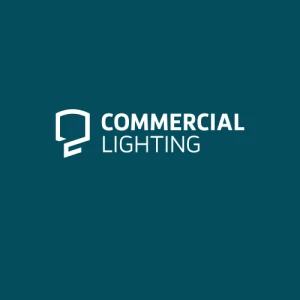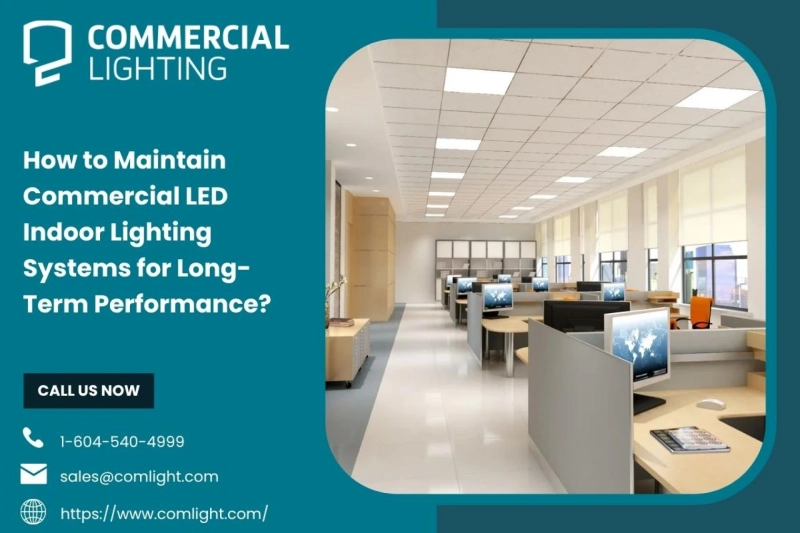With the trend towards efficiency and sustainability in business and the reduced cost of operation, the movement towards commercial LED indoor lighting has been common. The LED fixtures are highly energy efficient, have longer life, and have better quality of light than the older fluorescent or incandescent systems. These benefits are, however, much enjoyed in the long run when they are well cared for and maintained. Although LEDs are made of durable and long-life material, failure to maintain the products may limit their performance and performance of life, not to mention the fact that replacement costs will be higher.
This post will discuss tips we may apply in practice to keep commercial LED indoor lighting systems in optimal operation so that your business or retail space, warehouse, or office will be well-lit, productive, and efficient in the years to come.
Understand the Lifespan and Operational Behavior of LEDs
The LEDs do not go off abruptly, as was the case with the traditional bulbs. This is called lumen depreciation. The quality of a commercial LED indoor lighting system normally has a lifespan of about 50,000 and 100,000 working hours; however, this figure may change or fluctuate based on:
- Operating temperature
- Frequency of use
- Maintenance routine
- Power quality
This knowledge will assist you in planning preventative maintenance rather than responding to lighting failure and save time and money.
Monitor Heat Levels and Ensure Proper Ventilation
Even though the heat generated by LEDs is lower compared to other types of lighting, it generates heat, particularly when enclosed in a box. High temperatures reduce the lifetime of LEDs and may cause deterioration of electronic drivers.
To be at the best performance:
- Make sure that the decor or equipment is not blocked.
- Keep air vents and heat sinks clean.
- LEDs should not be installed around high-heat machinery.
Periodic ventilation checks in business premises such as restaurants, gyms, and industrial areas can significantly increase the duration of lights.
Inspect and Replace Drivers as Needed
The use of LEDs is regulated by drivers that control the power supply. These parts normally break down before the actual source of light, which is used as an LED. When lights start flickering, going dim, or going out in batches, then the driver, not the LED, has a problem.
Solution: Have driver inspections once a year. The benefit of having spare drivers on site is that whenever there is a need to replace a driver, it is possible to do this without delay.
Use Smart Lighting Controls to Reduce Wear
Incorporating the use of lighting controls, including:
- Motion sensors
- Timers
- Dimmers
- Daylight harvesting lights
This will help to greatly prolong the existence of your commercial indoor LED lighting system. These functions enable lights to be active when they are required and automatically regulate the brightness according to the conditions and habits of use: decreasing the hours and energy wasted during unnecessary running.
Replace Fixtures Strategically: Not All at Once
It can be said that when lighting is starting to fade as one grows older than group revamping is worth considering; that is, changing several lights at the same time instead of changing them one by one. This also provides uniformity in the brightness throughout the facility and saves labor expenses incurred by visiting the facility to undertake upkeep tasks.
Nevertheless, when you have zoned lighting (e.g., light in a warehouse aisle, light in an office department), it can be very effective to replace areas.
Maintain Consistent Power Quality
The variable power may ruin the LEDs and their drivers. Voltage irregularities may happen in large commercial areas with heavy equipment (such as industrial motors, HVAC systems, or charging stations).
This kind of example is when the businesses were installing EV chargers in Vancouver, or other high-power charging equipment on their premises should be ensured that there is a proper balancing of power, or the lights will not go out. The use of surge protectors, voltage regulators, and measuring power assists in preventing electrical stress and wear-and-tear on the LED systems.
Work With Qualified Lighting Professionals
Although LEDs do not need service so often, professional maintenance is more precise and safer. Certified technicians can:
- Carry out energy audits to optimize output.
- Detecting fixture issues early.
- Suggest improvements, such as intelligent control systems.
- Make certain that there are rules of compliance with the lighting at the workplace.
If your facility also incorporates modern systems like EV chargers in Vancouver, having professionals who are knowledgeable on power distribution as well as LED lighting will guarantee that the operations are as reliable as possible.
Keep Fixtures Clean and Dust-Free
Dust accumulation is usually not noticed, but it can have a great effect on performance. Dirt on LED lenses can:
- Block light output.
- Due to heat accumulation, hotspots are caused.
- Reduce efficiency
- Poor general use of lighting in the room.
Maintenance Advice: Cleaning Schedule. Wipe off lenses, casings, and panels around them with a microfiber cloth and non-abrasive and ammonia-free cleaning solution. Safe ladder procedures should be observed, or a facility maintenance service shall be employed to install lights on high ceilings or in a warehouse setup.
Conclusion
Commercial LED indoor lighting systems are a powerful investment that can significantly enhance efficiency, atmosphere, and cost savings in business environments. Proactive maintenance is required, however, to realize the maximum advantage. Simple cleaning schedules and driver supervision are only the beginning of smart lighting controls and professional inspection; all these steps contribute to the maintenance of the quality of lighting and extending the life of the system.
Having a disciplined maintenance strategy will help your LED lighting to continue providing outstanding performance and to maintain your workspace bright, efficient, and sustainable long into the future.



